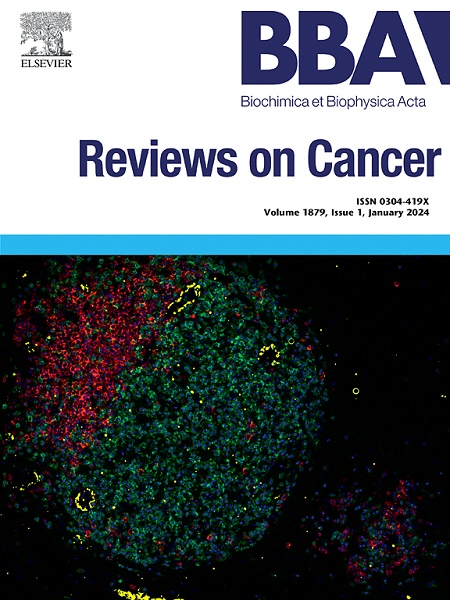肿瘤微环境中癌细胞与肿瘤相关巨噬细胞的相互作用
IF 9.7
1区 医学
Q1 BIOCHEMISTRY & MOLECULAR BIOLOGY
Biochimica et biophysica acta. Reviews on cancer
Pub Date : 2025-05-07
DOI:10.1016/j.bbcan.2025.189344
引用次数: 0
摘要
肿瘤微环境(Tumor microenvironment, TME)是指各种癌细胞生长的局部环境,包括肿瘤细胞、邻近的非肿瘤细胞以及相关的非细胞因素,这些因素共同促进了癌症的发生和进展。作为TME中的主要免疫成分,肿瘤相关巨噬细胞(tumor-associated macrophages, tam)通过与癌细胞的相互作用对癌症行为产生相当大的影响。癌细胞与tam之间的相互作用回路,包括来自癌细胞和tam的分泌因子,对各种癌症的增殖、干细胞、耐药、侵袭、迁移、转移和免疫逃逸至关重要。癌细胞通过释放旁分泌蛋白(HMGB1、AREG等)、细胞因子(IL-6、CCL2等)、rna (miR-21-5p、circPLEKHM1、LINC01812等)和代谢物(乳酸、琥珀酸等)调控TAMs的极化表型、介质分泌和功能。反过来,tam中的介质(TGF-β, IL-10, IL-6等)促进癌症进展。本文就TME中癌细胞与tam相互作用回路的研究进展进行综述。抑制tam的募集和M2极化,将tam从M2表型重编程为M1表型,阻断tam介导的免疫抑制和免疫逃逸,并结合现有的免疫治疗,可靶向tam克服各种癌症的免疫治疗耐药。新的突破在于确定药物开发的有效靶点,改进给药系统以提高给药效率,采用联合治疗。针对分泌因子、细胞表面受体、细胞内信号通路和癌细胞与tam之间相互作用回路中的代谢调节的干预有望抑制癌症进展并改善治疗效果。本文章由计算机程序翻译,如有差异,请以英文原文为准。

Interactions between cancer cells and tumor-associated macrophages in tumor microenvironment
Tumor microenvironment (TME) refers to the local environment in which various cancer cells grow, encompassing tumor cells, adjacent non-tumor cells, and associated non-cellular elements, all of which collectively promote cancer occurrence and progression. As a principal immune component in the TME, tumor-associated macrophages (TAMs) exert a considerable influence on cancer behaviors via their interactions with cancer cells. The interactive loops between cancer cells and TAMs, including secretory factors derived from both cancer cells and TAMs, are crucial for the proliferation, stemness, drug resistance, invasion, migration, metastasis, and immune escape of various cancers. Cancer cells release paracrine proteins (HMGB1, AREG etc.), cytokines (IL-6, CCL2 etc.), RNAs (miR-21-5p, circPLEKHM1, LINC01812 etc.), and metabolites (lactic acid, succinate etc.) to regulate the polarization phenotype, mediator secretion and function of TAMs. In turn, mediators (TGF-β, IL-10, IL-6 etc.) from TAMs promote cancer progression. This review summarizes recent advancements in the interactive loops between cancer cells and TAMs in TME. Inhibiting the recruitment and M2 polarization of TAMs, reprogramming TAMs from M2 to M1 phenotype, blocking TAMs-mediated immunosuppression and immune escape, and combining with existing immunotherapy can target TAMs to overcome immunotherapy resistance in various cancers. The new breakthroughs lie in identifying effective targets for drug development, improving the drug delivery system to enhance the drug delivery efficiency, and adopting combined therapy. Interventions targeting secretory factors, cell surface receptors, intracellular signaling pathways, and metabolic modulation in the interactive loops between cancer cells and TAMs are expected to suppress cancer progression and improve therapeutic effects.
求助全文
通过发布文献求助,成功后即可免费获取论文全文。
去求助
来源期刊

Biochimica et biophysica acta. Reviews on cancer
医学-生化与分子生物学
CiteScore
17.20
自引率
0.00%
发文量
138
审稿时长
33 days
期刊介绍:
Biochimica et Biophysica Acta (BBA) - Reviews on Cancer encompasses the entirety of cancer biology and biochemistry, emphasizing oncogenes and tumor suppressor genes, growth-related cell cycle control signaling, carcinogenesis mechanisms, cell transformation, immunologic control mechanisms, genetics of human (mammalian) cancer, control of cell proliferation, genetic and molecular control of organismic development, rational anti-tumor drug design. It publishes mini-reviews and full reviews.
 求助内容:
求助内容: 应助结果提醒方式:
应助结果提醒方式:


